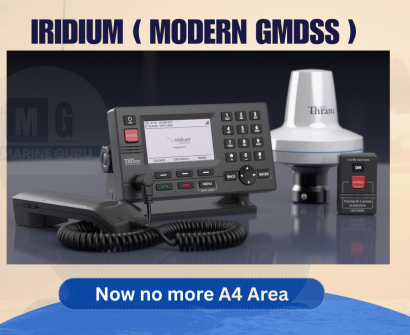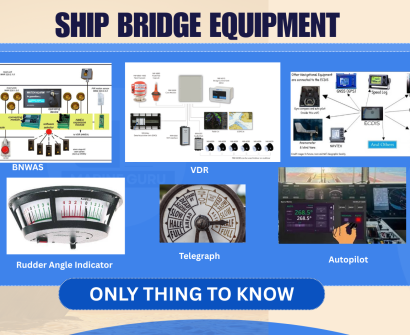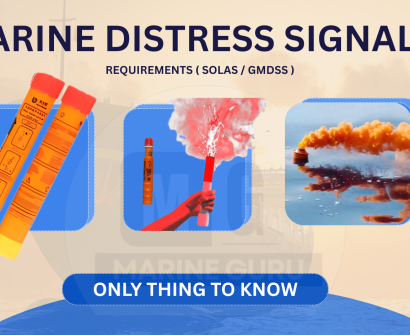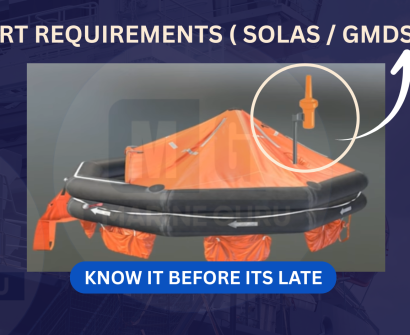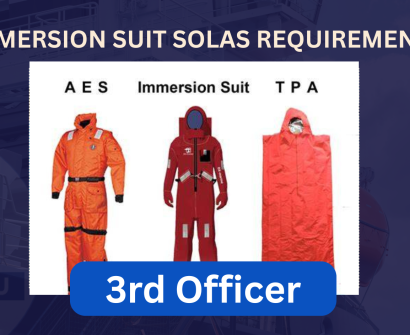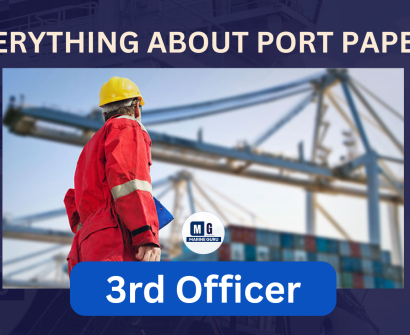
Snippet Summary
Under SOLAS Chapter III, every ship must carry lifeboats that are strong, fire-resistant, buoyant, self-righting (for passenger ships), and capable of safe launch at a ship speed of 5 knots with up to 20° list or 10° trim.
Each lifeboat must be approved by the administration, hold a certificate of approval, and contain sufficient equipment, buoyancy, and propulsion capacity to operate for 24 hours at 6 knots.
Why Lifeboat Standards Exist
The Safety of Life at Sea (SOLAS) Convention is the cornerstone of maritime safety, ensuring ships can protect all persons on board during an emergency. After the Titanic disaster (1912), SOLAS introduced strict rules for lifeboat design, construction, and carriage.
Modern lifeboats must now withstand harsh weather, operate independently for 24 hours, and carry survival equipment to sustain occupants until rescue (SOLAS Ch. III).
2. Types of Lifeboats (as per SOLAS)
| Type | Description | Key Features |
|---|---|---|
| Open Lifeboat | No roof, manually propelled by oars. | Obsolete now due to exposure and safety risks. |
| Partially Enclosed Lifeboat | Upper section covered, side openings for ventilation. | Used mainly on cargo vessels. |
| Totally Enclosed Lifeboat | Fully covered, watertight and self-righting. | Standard on passenger ships. |
| Free-Fall Lifeboat | Launched by gravity from stern ramp. | Aerodynamic design allows drop without damage (SOLAS Reg. 31). |
3. Design & Construction Requirements
Every SOLAS-compliant lifeboat must meet stringent construction standards to ensure seaworthiness and durability.
Material & Structure
- Built of Glass Reinforced Plastic (GRP), marine-grade aluminum, or fire-retardant steel.
- Must resist seawater, oil, UV exposure, and fungal attack.
- Should remain undamaged between −20°C and +65°C (SOLAS LSA Code 4.4.1.4).
- Must have non-skid flooring, anti-slip walkways, and corrosion-proof fittings.
Strength Tests
- Withstand a free drop of 3 meters without structural failure.
- Resist a lateral impact of 3.5 m/s against ship’s side when fully loaded (LSA Code 4.4.1.5).
- Maintain shape and integrity even when flooded.
Self-Righting Ability
- Passenger ship lifeboats must automatically return to upright position if capsized (SOLAS Reg. 36).
- The center of gravity and hull curvature ensure positive GM (metacentric height).
4. Buoyancy & Stability Requirements
- Must contain inherent buoyant material (non-water-absorbent and oil-resistant).
- Buoyancy Force: ≥ 280 N per person carried (LSA Code 4.4.1.6).
- Freeboard: ≥ 1.5% of boat length or 100 mm, whichever greater.
- Must stay afloat even when flooded and open to the sea.
- When loaded with 50% of persons on one side, lifeboat must still have positive stability (SOLAS Reg. 31.1).
5. Propulsion & Performance Standards
- Engine Type: Compression ignition (diesel).
- Fuel Flash Point: ≥ 43°C (closed cup test).
- Engine Start: Within 2 minutes at −15°C ambient temperature (LSA Code 4.4.3.1).
- Starting Systems: Manual and power-operated, with two independent batteries.
- Speed Requirements:
- 6 knots (fully loaded for 24 hours).
- 2 knots when towing a 25-person life raft.
- Launch Capability: Must launch safely when ship making 5 knots headway, with 20° list or 10° trim.
- Clearance: At least 30 cm between lifeboat and ship’s hull during lowering.
- Exhaust: Must prevent seawater entry and remain operational after immersion.
6. Lifeboat Equipment (SOLAS LSA Code 4.4.8)
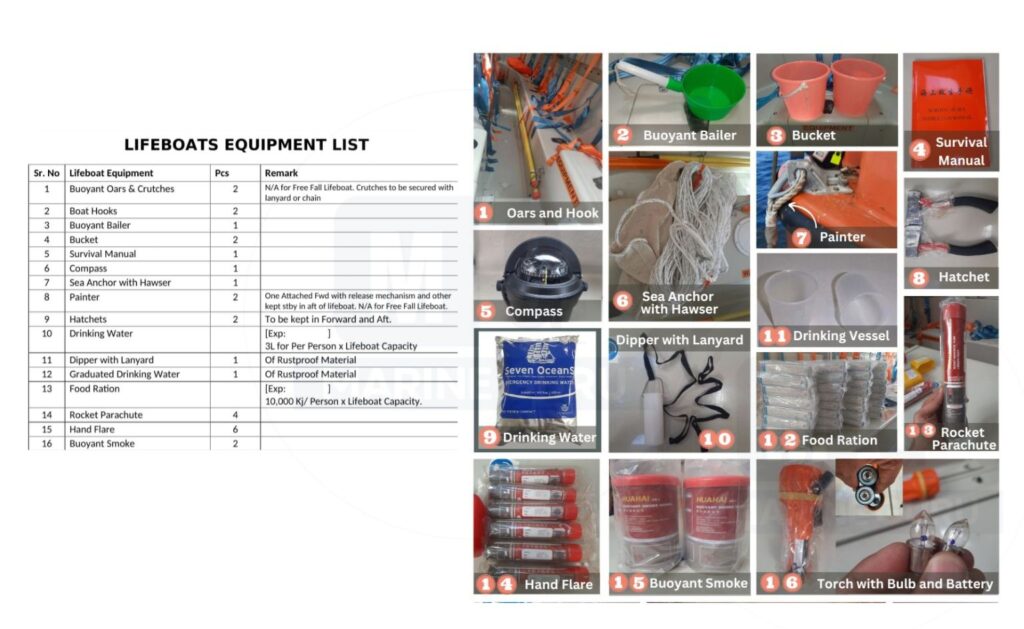
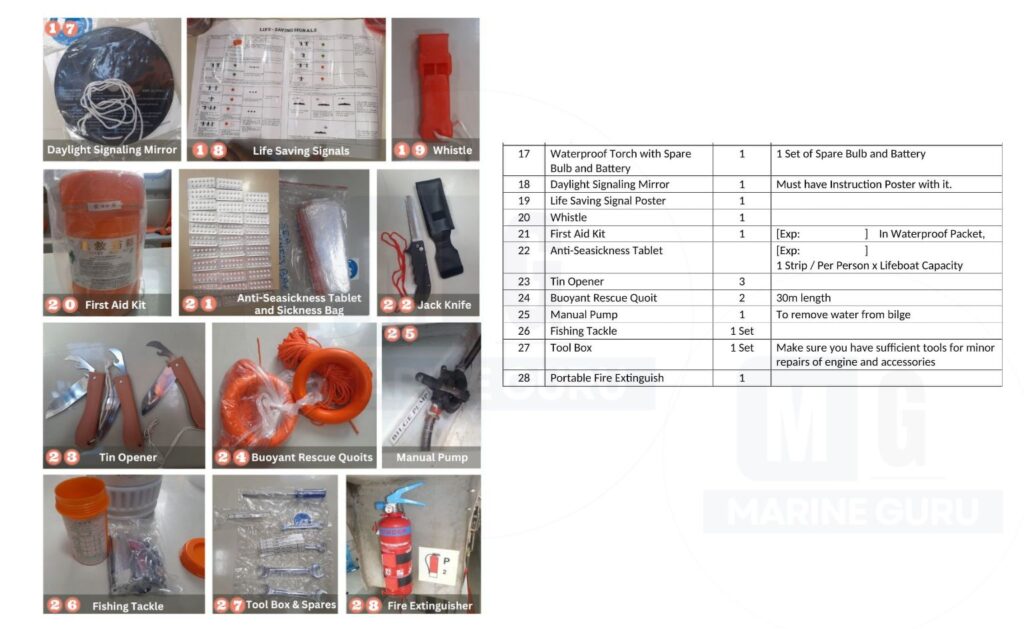
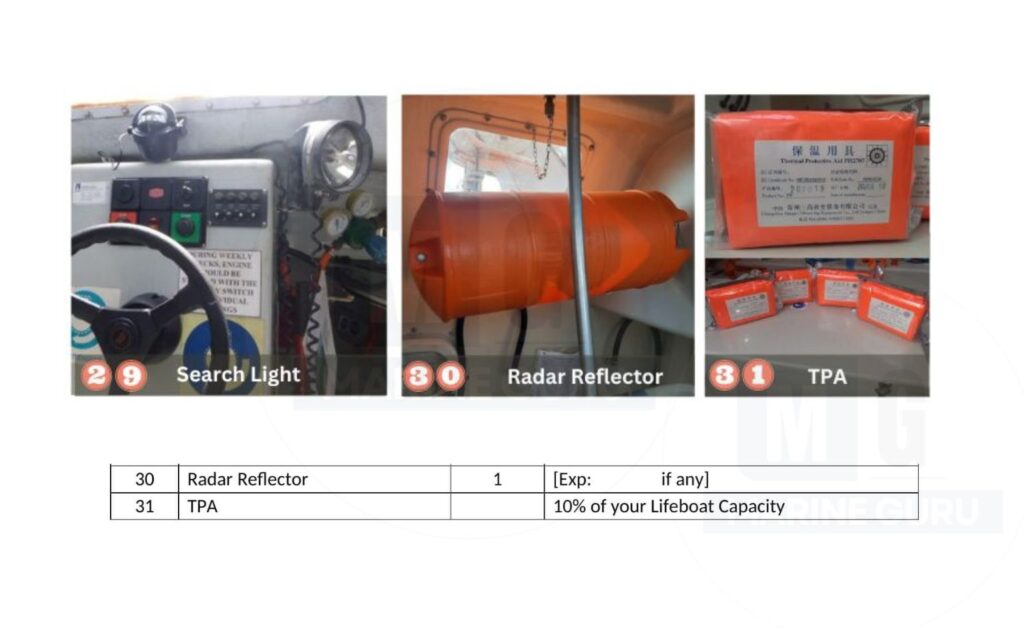
Each lifeboat must carry essential equipment to support survival, navigation, and rescue operations.
| Category | Equipment |
|---|---|
| Navigation & Control | Compass, sea anchor, 2 painters, 2 boat hooks |
| Survival Equipment | Food rations ≥10,000 kJ/person, water (3L/person), anti-seasickness tablets |
| Pyrotechnics | 4 rocket parachute flares, 6 hand flares, 2 buoyant smoke signals |
| Illumination | Waterproof torch (spare batteries), searchlight visible ≥2.5 km |
| Tools & Repair | Tool kit, jackknife, 3 tin openers, fishing tackle, portable fire extinguisher |
| Protection | 8 Thermal Protective Aids (TPAs) |
| First Aid | First aid kit with bandages, antiseptics, and anti-nausea medicine |
| Signaling | Daylight mirror, whistle, radar reflector, waterproof survival manual |
| Documentation | Lifesaving signals card and SOLAS operational checklist |
7. Launching, Boarding & Release Mechanisms
- Must allow full complement boarding within 3 minutes (cargo ships).
- Equipped with boarding ladders extending 0.4 m below waterline.
- Simultaneous release hooks operable from inside.
- Must ensure safe disengagement at both “on-load” and “off-load” conditions (SOLAS Reg. 34).
- Painter line system must allow towing at 5 knots without instability.
8. Markings & Certification
Each lifeboat must display:
- Ship’s name and port of registry (Roman script).
- Lifeboat number and capacity (visible from above).
- Manufacturer, model, serial number, and administration approval mark.
- Certificate of Approval including test date, weight, and carrying capacity (SOLAS Reg. 35).
9. Carriage Requirements (Passenger & Cargo Ships)
Passenger Ships (SOLAS Reg. 21)
- Must carry enough lifeboats for all persons on board (100%).
- On each side, lifeboats must accommodate at least 50% of total persons.
- If lifeboats cannot accommodate everyone, life rafts must supplement remaining capacity.
- Free-fall lifeboats permitted on certain passenger ships with aft launch positions.
Cargo Ships (SOLAS Reg. 31)
- Each side must have lifeboats for 100% of total persons.
- Ships <85 m may carry one lifeboat and life rafts on opposite sides.
- They must be readily accessible from muster stations.
- Free-fall lifeboats common on oil tankers, chemical carriers, and bulk carriers.
Additional Carriage Points
| Ship Type | Placement | Type |
|---|---|---|
| Tankers / Bulk Carriers | Stern free-fall type | Enclosed, self-righting |
| Passenger Ships | Both port & starboard | Totally enclosed |
| Cargo Vessels | Each side | Partially / Totally enclosed |
10. Training, Maintenance & Inspection
- Drills: Every crew member must participate in a lifeboat drill at least once a month (SOLAS Reg. 19).
- Launching: Each must be launched and maneuvered in water every 3 months.
- Engine Test: Run for 5 minutes weekly during inspection.
- Maintenance:
- Monthly inspection for hull, release gear, and engine.
- Annual servicing by approved lifeboat service provider.
- Crew Familiarization: All seafarers must know launch, release, and rehook procedures before sailing.
Video Credit: Nihal Gupta
11. Key Specifications Summary Table
| Parameter | Requirement |
|---|---|
| Max Capacity | 150 persons |
| Material | GRP / Aluminum / Fire-retardant Steel |
| Drop Test | ≥ 3 m |
| Impact Resistance | 3.5 m/s |
| Launch Speed | 5 knots (ship headway) |
| Operation | 24 hours @ 6 knots |
| Engine Start | Within 2 min @ −15°C |
| Fuel Flash Point | ≥ 43°C |
| Buoyancy Force | 280 N/person |
| Freeboard | ≥1.5% L or 100 mm |
| Temperature Range | −20°C to +65°C |
FAQs
Q1: What is the minimum speed of a Lifeboat as per SOLAS?
A lifeboat must move at 6 knots for 24 hours when fully loaded, and 2 knots while towing a life raft (SOLAS LSA Code 4.4.6.1).
Q2: What should be the flash point of lifeboat fuel?
Minimum 43°C (closed cup test) (LSA Code 4.4.3.1).
Q3: What is the minimum drop test height for a lifeboat?
At least 3 meters without structural damage (LSA Code 4.4.1.5).
Q4: What is the maximum number of persons allowed in a lifeboat?
Maximum 150 persons (SOLAS LSA Code 4.4.2.1).
Q5: What are the lifeboat carriage requirements for cargo ships?
Cargo ships must have lifeboats for 100% of persons on each side (SOLAS Reg. 31.1).
Q6: What is the starting temperature requirement for the lifeboat engine?
Must start at −15°C within 2 minutes (LSA Code 4.4.3.1).
Q7: What are the training requirements under SOLAS for lifeboats?
One monthly drill and one launch every 3 months (SOLAS Reg. 19).
Q8: What is the inherent buoyancy requirement?
Minimum 280 N per person, unaffected by seawater or oil (LSA Code 4.4.1.6).
Q9: Where is the painter secured on a lifeboat?
Near the bow, with a release system operable from inside (SOLAS Reg. 34).
Q10: What temperature range must a lifeboat withstand during storage?
Between −20°C to +65°C (LSA Code 4.4.1.4).



